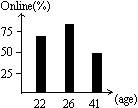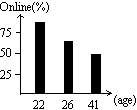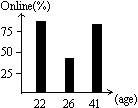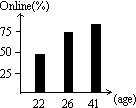A typical① Chinese Internet user is a young male who prefers instant messaging to e-mail, seldom makes online purchases② and favors news, music and games sites. According to a study, about two-thirds of survey participants③ use the Internet for news — often entertainment-related — or for online games. About half download music and movies.
They also tend to prefer instant messaging to e-mail, and they are depending on the Internet more frequently than before to communicate with others who have the same professions, hobbies and political interests. Online purchases still remain unpopular in China. Three-quarters of users surveyed have never bought anything over the Internet, and only 10 percent make purchases even once a month. Among those who do buy online, most pay for entertainment while others buy phone cards, or computer hardware or software.
“Many people don’t trust the quality of goods bought online,” Guo said Wednesday. “If they buy it in a store and don’t like it, they can easily bring it back.”
The survey was done in five major cities: Beijing, Shanghai, Guangzhou, Chengdu and Changsha. Results do not necessarily project countrywide because Internet use in rural areas is lower than in cities. Guo describes the typical netizen in the five cities surveyed as young, male, richer and more highly educated. Males make up two-thirds of the Internet community, and more than 80 percent of users are under 24. Among people ages 25 to 29, 60 percent to 80 percent go online.
China has more than 100 million people online, second in the world to the United States.
1. A typical Chinese Internet user will be the one who ______.
A. likes to send e-mails B. likes to buy goods online
C. likes to pay for entertainment D. likes the games sites
2. Online purchases still remain unpopular in China mainly because ______.
A. it is more difficult for sales returns B. people haven’t computers
C. people can’t have a look at the goods D. goods bought online are of low quality
3. Which of the following words fails to describe the typical netizens in the five cities?
A. well educated B. richer C. female D. young
4. According to the text, which of the following shows the right relation between online people and their ages?
A. B.
B.
C. D.
D. 
DACB
1. D 细节理解题。由文章的第一段的第一句话“...”可知。
2. A 由文章的第三段可知。人们不相信质量,但并不一定质量就低。
3. C 由文章的第四段的第三句可知。
4. B 由文章的第四段可知,24岁以下上网的人最多。因此22岁最高。

